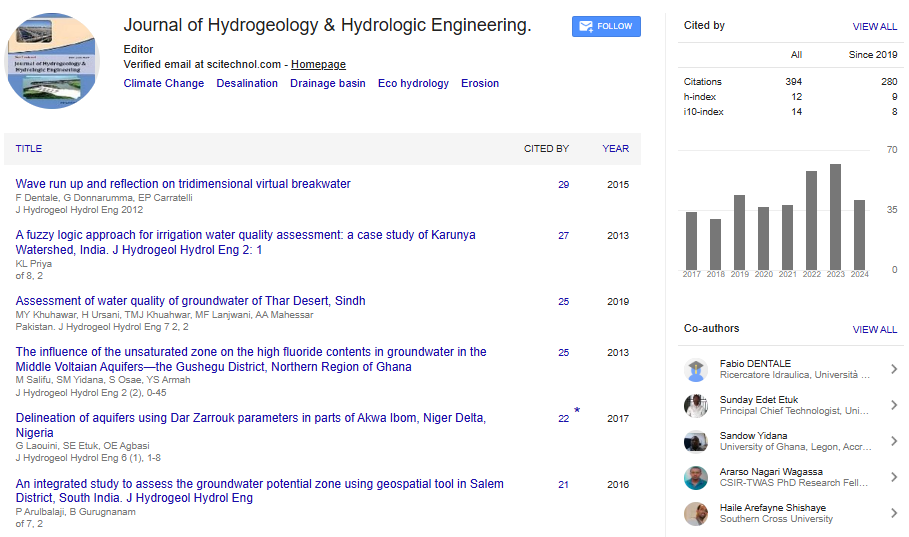Perspective, J Hydrogeol Hydrol Eng Vol: 13 Issue: 5
Effective Strategies in Watershed Management: Enhancing Water Resources for a Sustainable Future
Rajesh Kumar*
1Department of Ecohydrology, Stanford University, Stanford, USA
*Corresponding Author: Rajesh Kumar,
Department of Ecohydrology, Stanford
University, Stanford, USA
E-mail: kumarr36@gmail.com
Received date: 23 September, 2024, Manuscript No. JHHE-24-153106;
Editor assigned date: 25 September, 2024, PreQC No. JHHE-24-153106 (PQ);
Reviewed date: 09 October, 2024, QC No. JHHE-24-153106;
Revised date: 16 October, 2024, Manuscript No. JHHE-24-153106 (R);
Published date: 24 October, 2024, DOI: 10.4172/2325-9647.1000342
Citation: Kumar R (2024) Effective Strategies in Watershed Management: Enhancing Water Resources for a Sustainable Future. J Hydrogeol Hydrol Eng 13:5.
Description
Watershed management is a complete approach to managing water resources within a defined geographic area, aiming to sustain water quality, quantity and ecosystem health. This practice is essential in protecting natural water sources, supporting agricultural productivity, reducing pollution and ensuring reliable water supplies for communities. With increasing population pressures, climate change and industrialization, effective watershed management has become essential for sustainable environmental management. A watershed, also known as a catchment area, encompasses all land where precipitation collects and drains into a common outlet like a river, lake, or ocean. Watersheds are natural water filters that help purify water by trapping pollutants and facilitating groundwater recharge. They are precarious to biodiversity, water supply and agricultural and urban water demands.
Key components of watershed management
Watershed management integrates various practices that consider social, ecological and hydrological factors. The primary components include:
Soil and water conservation: Techniques such as terracing, contour farming and afforestation prevent soil erosion, promote water infiltration and enhance water quality. Soil conservation is particularly important in areas prone to land degradation.
Water resource assessment: A thorough understanding of water availability, quality and demand within the watershed is necessary. This involves monitoring rainfall patterns, surface water levels and groundwater recharge rates.
Pollution control: Managing agricultural runoff, industrial waste and urban pollutants is vital to prevent contamination of water bodies. Buffer strips, sediment ponds and constructed wetlands can trap pollutants before they enter waterways.
Land use planning: Coordinating land use with water management goals helps to protect water resources. Proper zoning, sustainable agriculture and controlled urban expansion can significantly reduce strain on the watershed.
Challenges in watershed management
Several challenges impact watershed management efforts, including:
Climate change: Changes in rainfall patterns and increased droughts strain water resources, making watershed management more complex. Unpredictable weather patterns make it difficult to plan long-term strategies.
Urbanization and industrialization: Expanding cities and industrial activities lead to deforestation, soil erosion and increased pollution. Urban areas contribute to higher surface runoff and reduced groundwater recharge, while industrial waste can contaminate water sources.
Agricultural practices: Unsustainable agricultural practices, such as overuse of chemical fertilizers and pesticides, contribute to water pollution and soil degradation. Intensive irrigation can also lead to groundwater depletion and water shortages.
Strategies for effective watershed management
To address these challenges, various strategies can be implemented, including:
Integrated Water Resource Management (IWRM): IWRM emphasizes coordinated planning and management of water, land and related resources. It aims to balance social, economic and environmental needs, ensuring sustainable water use within the watershed.
Use of technology: Remote sensing, Geographic Information Systems (GIS) and hydrological modeling tools help monitor water resources and predict future trends. These technologies enable realtime data collection and analysis, aiding decision-making in watershed management.
Ecosystem-based approaches: Incorporating ecosystem services into watershed management can enhance resilience. This includes preserving forests and wetlands, which act as natural water filters, improve biodiversity and provide flood control.
Restoration projects: Restoring degraded areas within watersheds, such as reforestation and wetland restoration, improves water quality, reduces soil erosion and enhances biodiversity. Restoration also aids in carbon sequestration and provides additional ecosystem benefits.
Education and community participation: Community involvement in watershed management ensures sustainable practices are adopted. Educational initiatives that highlight the importance of water conservation encourage local management.
Conclusion
Watershed management plays a vital role in achieving sustainable water resources. By implementing soil and water conservation practices, using advanced technologies, engaging communities and promoting ecosystem-based approaches, we can protect watersheds from the adverse effects of climate change, pollution and urbanization. Integrated watershed management ensures a healthier environment, supports agriculture and provides clean water for future generations. As we move forward, a proactive and collaborative approach is essential in preserving our watersheds for sustainable development.
 Spanish
Spanish  Chinese
Chinese  Russian
Russian  German
German  French
French  Japanese
Japanese  Portuguese
Portuguese  Hindi
Hindi 
